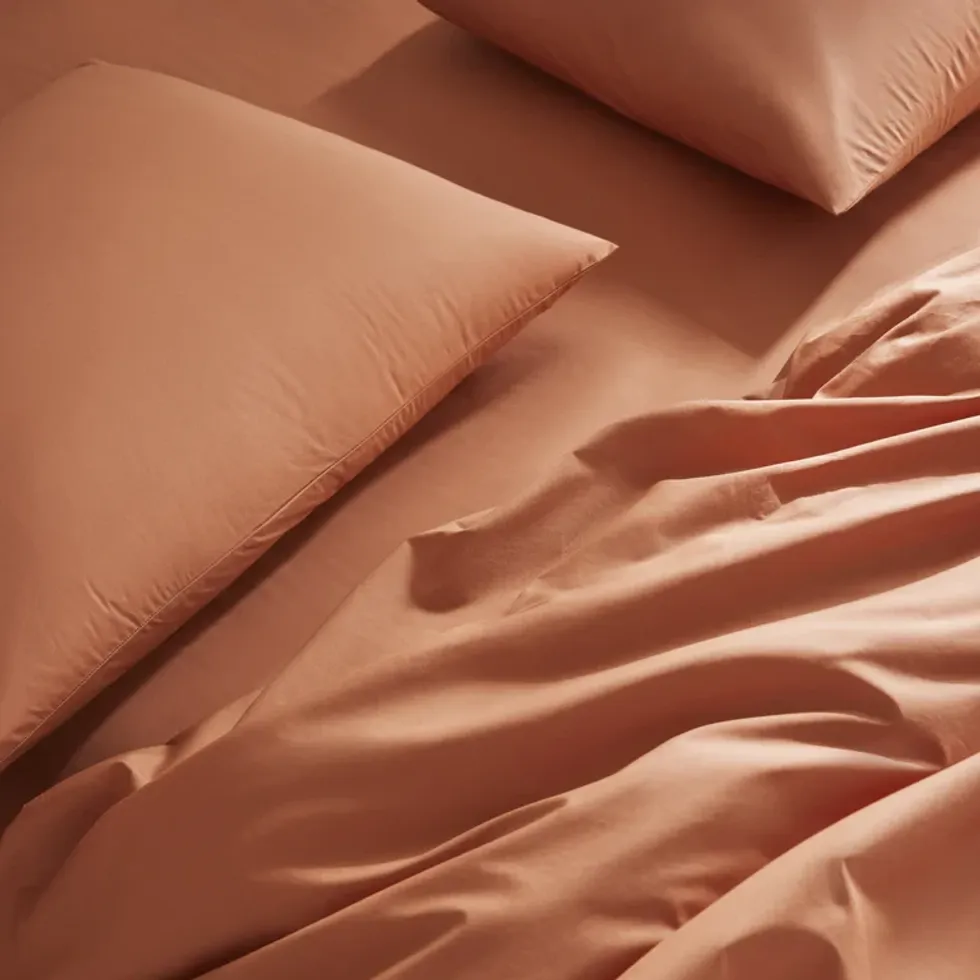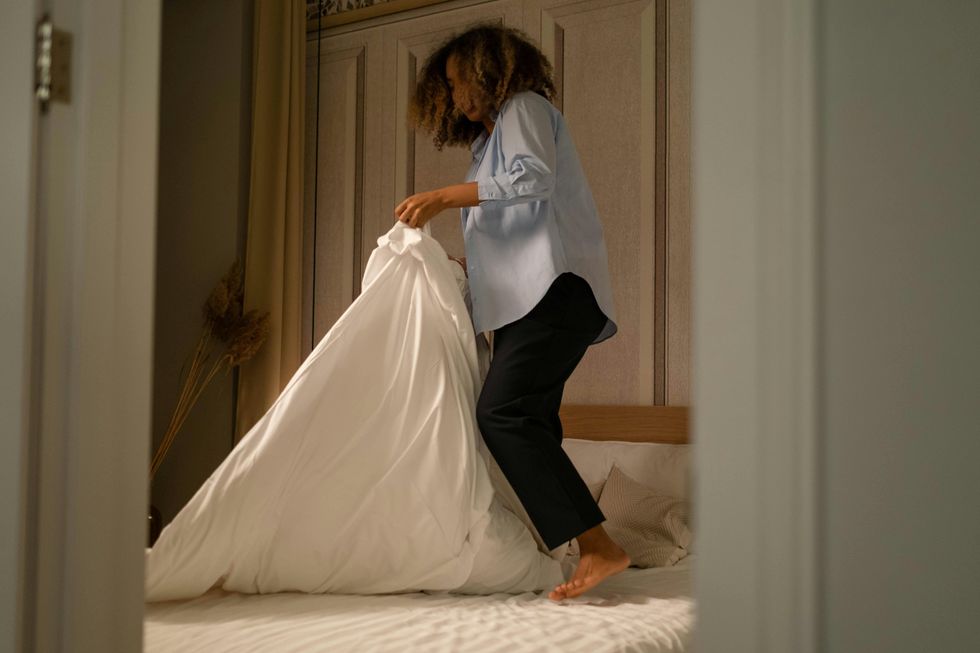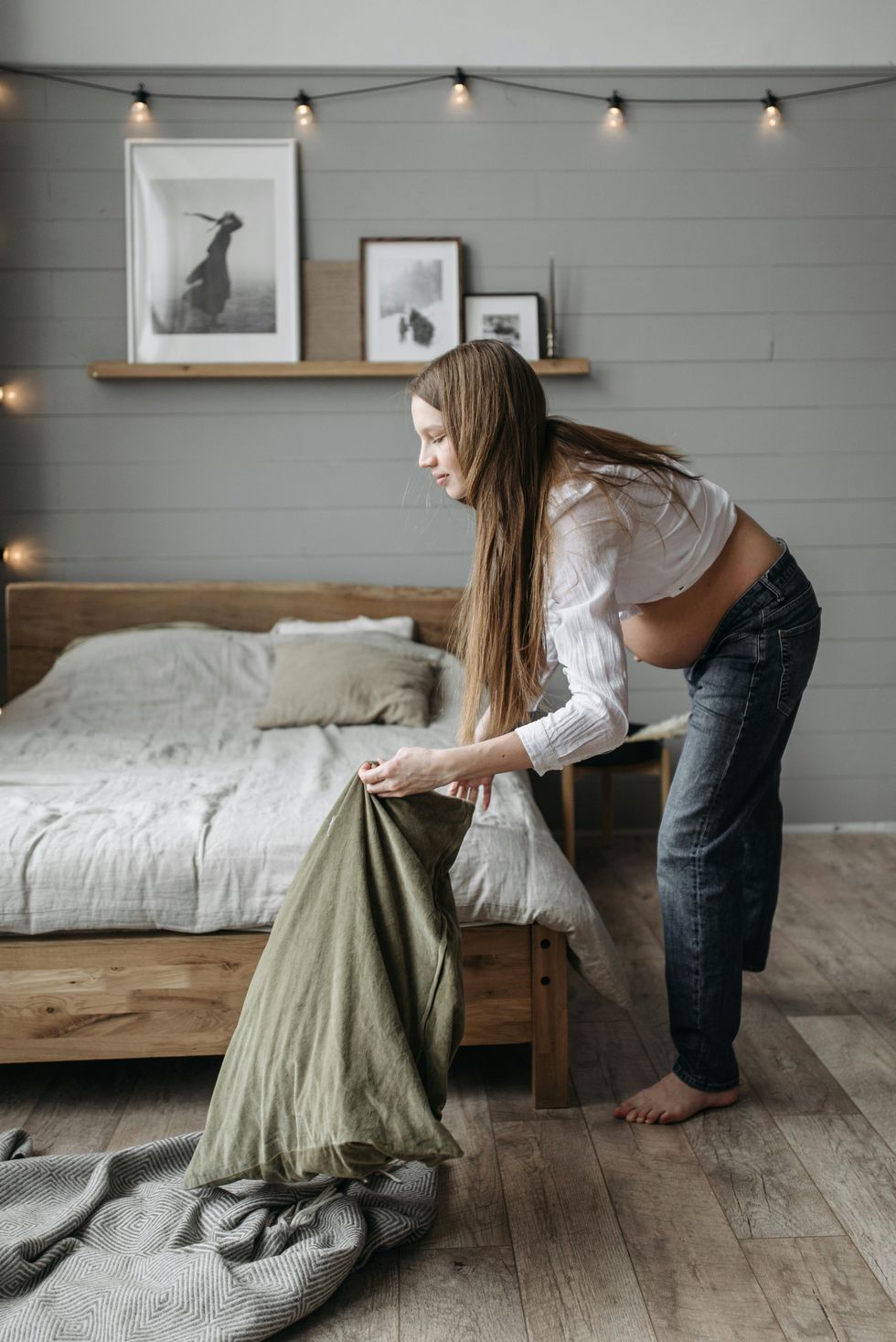Everything You Need To Know About Your Bed Sheets

Whatever happens during the day, you deserve to know comfort awaits you each night when you crawl into bed. Your bed sheets have everything to do with that. If you’re someone who’s chronically cold at night, or perhaps someone who shares your bed with a couple dogs, you ask a lot of your bed sheets. Picking the right fabric and giving them the proper care can make or break your quality of sleep.
Whatever your style or budget, you deserve sheets that lull you to sleep each night, keeping you comfy year-round and adding benefits to your life beyond how they look. From hypoallergenic to wrinkle-resistant, hand-washed, or easily maintained, consider this your guide to everything you should know about your bed sheets.
What is the best material for your bed sheets?

Image via Brooklinen
Picking bed sheets begins with understanding the pros and cons of different materials and fabrics. Before you settle on a color or a pattern, consider how much you’re willing to spend, how durable you need the sheets to be, and how you want your bed to feel. Soft, silky, thick, stretchy, breathable, and moisture-wicking are all commonly-used terms to describe how you might want your sheets to feel when you slip into bed at night. Consider these options:
- Cotton: A popular choice, cotton is natural and breathable, known for its comfort and variety of colors and patterns. Within the cotton family, there is a closely-woven version called percale cotton, which tends to be crisp, lightweight and cooling. Another option within cotton is sateen cotton, a silky-smooth option with a bit of a sheen.
- Linen: A super breathable option is linen, which only gets softer over time. It’s made from flax fibers, making it a natural fabric. If wrinkles aren’t your vibe, steer clear, but the relaxed, lived-in look is perfect for warm, beachy environments or warm sleepers.
- Microfiber: Synthetic fibers get a bad rep, but there’s a reason microfiber sheets are so popular. Whether they’re polyester or a blend of some kind, these low-maintenacne sheets are comfortable and easy on your wallet, plus they wash and wear easily.
- Flannel: A type of cotton that provides extra warmth, flannel is a perfect seasonable option or pick for anyone who’s always cold at night. It’s extra durable thanks to to teased cotton fibers that insulate you and your bed.
- Silk: This ultra smooth fabric is high-end-feeling and ideal for a variety of seasons. Silk is a natural fiber with a shiny finish. It’s cool in the summer and warm in the winter, and can be a perfect option for anyone with sensitive skin thanks to its hypoallergenic properties.
- Jersey: You may have seen them called “t-shirt sheets” because they feel soft, stretchy and as comfy as your most-loved tee. The knit fabric is relaxed and cozy, not quite as breathable as cotton, but undeniably soft.
- Alternative Fabrics: Often lumped together, bamboo, rayon, and tencel or lyocell, are known for their moisture-wicking properties. Each made from plant fibers, they’re the most eco-friendly choice and stay soft and breathable over time.
What is the best thread count for bed sheets?

Photo by Ron Lach / PEXELS
Odds are you’ve been standing in the bedding aisle contemplating the exact thread count to purchase, only to realize you’re not entirely sure what thread count is. So here’s a little breakdown: Thread count is the number of threads, horizontally and vertically, per square inch of the fabric. You may have heard that a higher thread count means better the quality and softer sheets, but this isn’t necessarily true. Thread count only applies to cotton sheets and there are ways to inflate these numbers without actually improving quality. A thread count between 300 and 600 is going to be the best bang for your buck.
Picking Sheets for Each Season (& Type of Sleeper)

Photo by cottonbro studio / PEXELS
Besides softness and look, your top priority when picking sheets is most likely temperature. Lighter, more breathable fabrics will always be preferred in the summer or year-round for anyone who tends to run hot at night. When temperatures drop, a warmer, thicker fabric will keep you comfortable and even save you from having the crank the heat. Anyone who spends their nights cold will appreciate these warmer fabrics.
- Warm Weather or Warm Sleepers: Opt for something light like linen or percale cotton, or a fabric that stays dry like bamboo or tencel.
- Cold Weather or Cold Sleepers: For extra warmth, flannel or jersey sheets will keep body heat in and ensure you stay cozy and comfortable all night.
Other Considerations When Picking Bed Sheets

Photo by cottonbro studio / PEXELS
Besides overall feel, you want to keep price and durability in mind. Higher priced bed sheets should last you a longer time, however, it’s often true that the more expensive, luxurious options actually require more maintenance.
For example, silk sheets, while elegant and opulent, can be a lot of work to maintain. They also tend to be more expensive than most bed sheet options. Silk is a delicate material that often requires hand-washing, gentle detergents, and mild temperatures. Not to mention, it’s prone to wrinkling and won’t stand up to things like pets. However, on the flip side, many people swear by the hypoallergenic and beauty benefits of silk for keeping your skin and hair clean and glowy. Linen and Egyptian cotton (a premium version of cotton known for its extra-long fibers) are other high-maintenance options that tend to be more expensive.
Alternatively, microfiber sheets are the most affordable option of the bunch, and because of how low maintenance they are, they’ve become one of the most popular options. They wash well in a machine and come out of the dryer wrinkle-free; not to mention they are stain resistant and thanks to their close weave, they’re hypoallergenic. Jersey and percale cotton are other affordable options that hold up well over time and with moderate maintenance.
How To Care for Your Bed Sheets

Photo by Pavel Danilyuk / PEXELS
Regardless of the fabric you choose, proper care can make your bed sheets last longer and sleep cozier. Beyond the effects on the sheets themselves, caring your bed sheets can improve your overall health and sleep. Each fabric may vary a little when it comes to care, but keep these general guidelines in mind:
Bed Sheet Washing Instructions
- It’s best to wash your sheets every 1-2 weeks to remove dander, stains, crumbs, and more. If you have sensitive skin, consider washing them more frequently.
- Wash colored sheets on lower temperatures to prevent fading or bleeding, but wash whites on warmer temperatures to sanitize and remove stains.
- When it comes to drying, consider tumble drying or even hanging them to dry. If you do use the dryer, remove them quickly to avoid wrinkles.
- Wash sheets on their own, or with other linens like towels, to avoid snags.
- Avoid harsh chemicals like bleach, which can damage the fibers over time.
When to Replace Bed Sheets
- If you notice thinning or holes, it’s time to buy new sheets
- If the fitted sheet’s elastic no longer fits snugly over your mattress, consider new sheets.
- With proper care, most sheets only last for 2-3 years before needing to be replace for hygiene and softness.
Other Bed Sheet Tips
- Consider swapping your sheets throughout the seasons for better comfort and longevity of your sets.
- When you’re not using the sheets, store them properly in a cool, dry place.
Picking the right bed sheets are a lot like picking the right mate. You need support, comfort, softness, and it shouldn’t be too much more to keep the magic alive. Before you invest in your next set, consider your sleeping habits, preferences, and budget, beyond just the patterns you like. You’ll be happier with your purchase and sleep soundly knowing you made the best decision for yourself.
Looking for some home goods to add to your space? Check out our storefront!
Header image via Karolina Grabowska / PEXELS



















